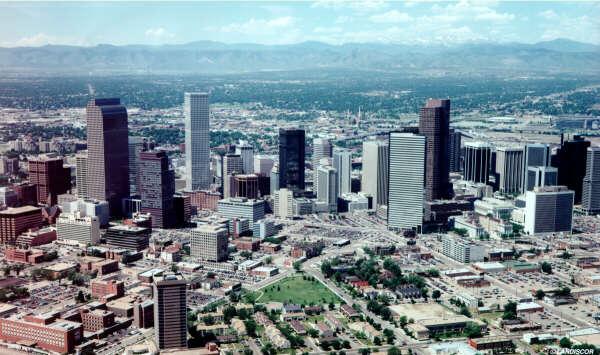

Denver Skylines and Neighborhoods Photos
Other Metro Area Skylines and Neighborhoods Photos
New LoDo/Union Station/Central Platte Valley Projects
New Cherry Creek/Glendale/Colorado Blvd Projects
New Highland Neighborhood Projects
New Ballpark/Curtis Park Projects
New Golden Triangle/Capitol Hill Projects
Denver, the capital of Colorado, was established by a party of prospectors on November 22, 1858, after a gold discovery at the confluence of Cherry Creek and the South Platte River. Town founders named the dusty crossroads |
 |
|
for James W. Denver, Governor of Kansas Territory, of which eastern Colorado was then a part. Other gold discoveries sparked a mass migration of some 100,000 in 1859-60, leading the federal government to establish Colorado Territory in 1861. Denverites built a network of railroads that made their town the banking, minting, supply and processing center not only for Colorado, but for neighboring states. Between 1870 when the first railroads arrived and 1890, Denver grew from 4,759 to 106,713. In a single generation, it became the second most populous city in the West, second only to San Francisco. Although founded as the main supply town for Rocky Mountain mining camps, Denver also emerged as a hub for high plains agriculture. Denver’s breweries, bakeries, meat packing and other food-processing plants made it the regional agricultural center, as well as a manufacturing hub for farm and ranch equipment, barbed wire, windmills, seed, feed and harnesses. The depression of 1893 and repeal of the Sherman Silver Purchase Act abruptly ended Denver’s first boom. Civic leaders began promoting economic diversity—growing wheat and sugar beets, manufacturing, tourism and service industries. The Denver Livestock Exchange and National Western Stock Show confirmed the city’s role as the "cow town" of the Rockies. Denver began growing again after 1900, but at a slower rate. Stockyards, brickyards, canneries, flour mills, leather and rubber goods nourished the city. Of many Denver-area breweries, only Coors has survived, becoming the nation’s third largest sudsmaker. Regional or national headquarters of many oil and gas firms in the Mile High City fueled much of Denver’s post-World War II growth and an eruption of 40- and 50-story high-rise buildings downtown, during the 1970s. Denver’s economic base has come to include skiing and tourism, electronics, computers, aviation and the nation’s largest telecommunications center. As the regional center of a vast mountain and plain hinterland, Denver boasts more federal employees than any city besides Washington, D. C. Since the 1940s, the large federal center, augmented by state and local government jobs, has somewhat stabilized the city’s boom-and-bust cycle. Visually, Denver is notable for it predominance of single-family housing and its brick buildings. Good brick clay underlies much of the area, while local lumber is soft, scarce and inferior. Even in the poorest residential neighborhoods, single-family, detached housing prevails, reflecting the Western interest in "elbow room" and a spacious, relatively flat, high plains site, where sprawling growth is unimpeded by any large body of water or geographic obstacle. Denver’s 1970s energy boom spurred a proliferation of suburban subdivisions, shopping malls and a second office core in the suburban Denver Tech Center. Denver’s traditional dependence on non-renewable natural resources returned to haunt the city during the 1980s oil bust. When the price of crude oil dropped, Denver sank into a depression, losing population and experiencing the highest office vacancy rate in the nation. Notable institutions include the Denver Museum of Natural History, the Denver Public Library, the Colorado History Museum, the Denver Art Museum and the Denver Center for the Performing Arts, as well as the U.S. Mint and major league baseball, basketball, football, hockey and soccer teams. Gun violence and crime, as well as smog, and traffic congestion are among the principal problems. As one of the most isolated major cities in the United States, Denver always has been obsessed with transportation systems. Fear of being bypassed began early when railroads and later, airlines, originally avoided Denver because of the 14,000-foot-high Rocky Mountain barrier just west of town. To secure Denver’s place on national transportation maps, the city opened a new multi-billion dollar airport in 1995. The 55-square-mile Denver International Airport is the nation’s largest in terms of area and capacity for growth, prompting boosters to call it the world’s largest. Denver is a sprawling city in a state of long distances and mountainous obstacles. To tackle long distances and tough terrain, Coloradans have become auto-dependent. Denver has one of the highest per-capita motor vehicle ownership rates in the country—with an average of one licensed vehicle for every man, woman and child. In the 1990s, Denver built an outer ring of freeways that immediately became over-congested. Even after the Regional Transportation District began building a light-rail system, highway congestion remained the number-one complaint of many Denverites. In 2000, the metro area reached a population of 2.62 million, three-fourths of whom live in the suburban counties—Adams, Arapahoe, Boulder, Denver, Douglas, Jefferson and Weld. Roughly 20 percent of the core city population was Spanish-surnamed, 13 percent African-American, two percent Asian and one percent Native American. Denver has elected Hispanic (Fredrico Peņa, 1983-91) and African-American (Wellington Webb, 1991-2001 and Michael Hancock, 2012-present) mayors in recent years and has enjoyed relatively smooth race relations. The Rocky Mountain metropolis boomed during the 1990s, as the eastern suburb of Aurora became Colorado’s third-largest city and the western suburb of Lakewood became the fourth-largest. Even the core City and County of Denver gained population in the 1990s for the first time since the 1970s, climbing once again beyond the 500,000 mark. Thanks to landmark districts preserving venerable business and residential areas, as well as the 1990s opening in the core South Platte River Valley of Coors Baseball Field, Elitch Gardens Amusement Park, Ocean Journey Aquarium, Pepsi Center and many new housing projects, downtown Denver is booming as well as its suburban fringe, at the dawn of the 21st century. Denver's 2010 population was 600,024, an increase of about 8 percent from 2000. By 2015, the population had reached 682,545. Denver Area Facts |
|
